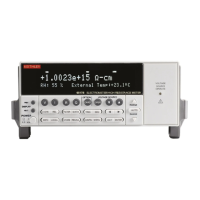Model 6517B Electrometer Reference Manual Section 12: Common commands
6517B-901-01 Rev. C / August 2015 12-9
*OPC? (operation complete query)
This command places a 1 in the output queue after all pending operations are completed.
Details
On power-up, or when *CLS or *RST is executed, the Model 6517B goes into the operation complete
command query idle state (OQIS). In this state there are no pending overlapped commands. The
overlapped commands used by the Model 6517B are:
:INITiate:CONTinuous ON
:INITiate
*TRG
When the *OPC? command is sent, the Model 6517B exits from OQIS and enters the operation
complete command active state (OQAS). In OQAS, the instrument continuously monitors the no-
operation-pending flag. After the last pending overlapped command is completed (no-operation-
pending flag set to true), an ASCII character 1 is placed into the output queue, the message available
(MAV) bit in the status byte sets, and the instrument goes back into OQIS. Addressing the Model
6517B to talk sends the ASCII 1 to the computer.
Note that the instrument always goes into OQAS when *OPC? is executed. If there are no pending
command operations (for example, trigger model in idle state), the Model 6517B immediately places
an ASCII "1" in the output queue, sets the MAV bit and returns to OQIS.
When used with the :INITiate or :INITiate:CONTinuous ON command, an ASCII "1" is not
sent to the output queue and the MAV bit is not set until the Model 6517B goes back into the idle
state. The initiate operations are not considered finished until the instrument goes into the idle state.
The :INITiate:POFLag command is used to include or exclude the no-operation-pending flag in
the internal process of determining whether all pending operations of an initiate command are
completed.
When used with the *TRG command, an ASCII 1 is not placed into the output queue and the MAV bit
is not set until the operations associated with the *TRG command (and the initiate command) are
finished. The *TRG command is considered to be finished when the device action completes or when
operation stops at a control source to wait for an event (see IEEE-488 trigger model (on page 11-16)
for more information).
In order to use *OPC? exclusively with the *TRG command, you must force the completion of the
initiate command so that only the *TRG command is pending. To do this, send the :ABORt command
to place the instrument in idle, which (by definition) completes the initiate command. Since continuous
initiation is on, operation continues on into the trigger model. After sending the *TRG command, an
ASCII 1 is placed in the output queue and the MAV bit sets when the *TRG command is finished.
After *OPC? is executed, additional commands cannot be sent to the Model 6517B until the pending
overlapped commands have finished. For example, :INITiate:CONTinuous ON followed by
*OPC? locks up the instrument and requires a device clear (DCL or SDC) before it accepts any more
commands. See *OPC, *TRG, and *WAI for more information.
Also see
*OPC (on page 12-8)
*TRG (trigger) (on page 12-14)
*WAI (wait-to-continue) (on page 12-15)

